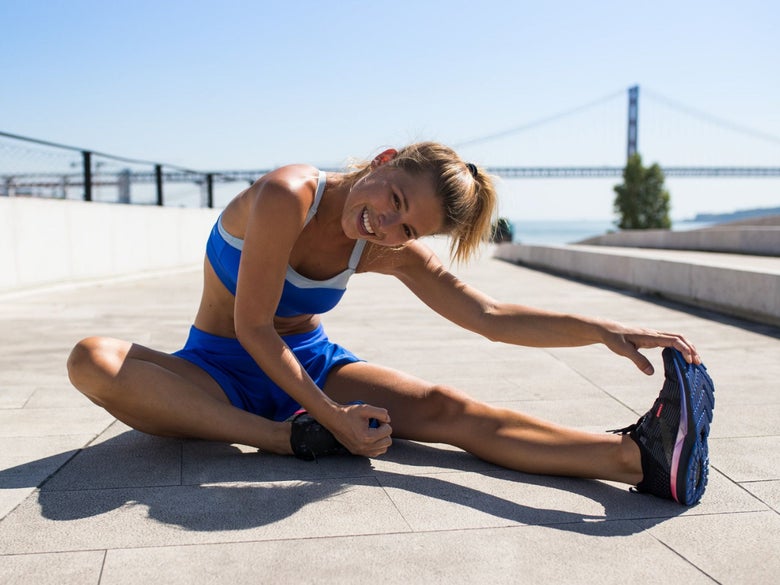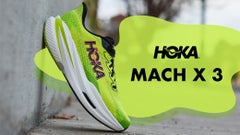How to Train During Your Menstrual Cycle
Discover how tracking your menstrual cycle can optimize your running performance and improve your overall health
Updated: October 1, 2024 by Caroline Cross

Have you ever noticed that working out becomes more challenging during different times of your menstrual cycle? And by menstrual cycle, we don't mean just when you are on your period. The menstrual cycle consists of four phases (menstrual, follicular, ovulation, and luteal) with four different hormones (estrogen, progesterone, FSH, and LH) that all play a role in your physical and emotional state, energy levels, and nutritional needs.
During each stage of a woman's cycle, the body releases different amounts of hormones, which in turn impact athletic performance in various ways. In this article, we break down the four phases to help you learn how they might affect your body and how you can use this knowledge to optimize your training, minimize injury, and maintain overall health.
Since women have varying cycle lengths, we will be providing dates of each phase within the average 28-day cycle (it typically ranges from 21 to 35 days). The length and duration of each phase can also change over time as women near menopause. Before we dive into each stage, let's first address a few common questions.
Common Questions
Can female runners perform well during menstruation?
Unequivocally yes! Women have set and broken records at marathons in all phases of their menstrual cycle.
How does the menstrual cycle affect running performance?
The effects on women's running performance vary based on each individual. As you may have noticed amongst your circle of friends, every woman's menstrual cycle is different according to the duration and heaviness of her period, the severity of premenstrual symptoms experienced, and her energy levels. Researchers have concluded that women have individual responses to how their menstrual cycle affects their marathon performance.
What are the benefits of tracking your menstrual cycle?
Period tracking helps you train smarter and perform better by providing you with a better understanding of your unique cycle, the internal hormonal changes occurring, and how to align your workouts and nutritional needs accordingly. Seeing how your hormones fluctuate helps explain variations in sleep, mood, metabolism, and appetite, which impact performance. Over time, you will begin to notice patterns and trends to help you make mindful choices on what kind of training works best during each phase, so you're not frustrated by off days when you're not firing on all cylinders. You can then set healthy and realistic goals by adjusting your workouts to achieve your personal best. For example, schedule your intense sessions (longer runs and sprints) on high-energy days, and plan slower, easy runs to avoid overtraining or injuries on lower energy days. Tracking will also help improve rest and recovery and give you a better idea of when you menstruate and ovulate, so you can be more in sync with your cycle.
How can you track your menstrual cycle?
Technology has made period tracking much easier and more efficient. From smartphone apps to GPS watches tailor-made for women, inputting your menstrual cycle data can be quick and effortless. With compatible Garmin watches, you can sync the menstrual cycle tracking widget to the Garmin Connect app and log your daily symptoms, see what phase you're in, and have access to your regular biometrics (such as heart rate). After a few months, you can observe your energy levels during different stages of your cycle to see patterns in your performance. You will also receive guidance around nutrition, training, and health, as well as period and fertility predictions and access to your previous cycles in a calendar format. If you prefer the old-school way of putting pen to paper, you can jot down the type of run, level of effort, and other symptoms (mood, appetite, energy, sleep, etc.) in a menstrual log. Whatever method you choose, period tracking keeps you better informed so you can be proactive in addressing your training and nutritional needs, working with your body instead of against it.
1. Menstrual Phase

The first stage of the menstrual cycle, as the name suggests, is when you start your period. The uterine lining is shed, and levels of estrogen and progesterone drop and are at their lowest, which leaves most ladies feeling sluggish or drained on the initial day. Some women experience cramps, bloating, tiredness, lower back pain, mood swings, headaches, and gastrointestinal (GI) issues. On average, menstruating women are in this phase for 3 to 7 days.
The amount of training and intensity you can handle depends on the severity of your symptoms. It is common for women to experience heavier bleeding for a couple of days, followed by gradually lighter days. However, every woman's menstrual cycle varies; some have regular periods timed like clockwork, while others have irregular cycles. Some females may experience a week of heavy bleeding with severe cramps, making it difficult to complete harder training efforts. Other women may experience lighter days with more tolerable symptoms. If your period symptoms are not severe, then this can be a good time for moderate-to high-intensity endurance workouts, such as tempo or threshold runs and strength-based training. As estrogen levels gradually rise, PMS symptoms subside and your body starts producing mood-lifting serotonin. You experience less discomfort and pain and more energy than on the initial days of menstruation to go out and tackle more miles.
Note: Due to menstrual bleeding at this phase of the cycle, the loss of blood contributes to a decrease in iron levels, so make sure you're getting enough iron in your diet.
2. Follicular Phase

The follicular phase also simultaneously begins on the first day of your period (so there is some overlap with the menstrual phase) and ends when you ovulate. The follicular phase lasts on average for 16 days (total can range from 11-27 days). During this stage, the hypothalamus signals to the pituitary gland to release follicle-stimulating hormone (FSH). Once released, FSH stimulates your ovaries to produce several small sacs (follicles) that contain immature eggs. Only a healthy follicle matures into an egg, and the rest of the sacs get absorbed into the body. The maturing egg causes a surge in estrogen. After your menstrual flow stops, the rise in estrogen prepares your body for ovulation, but progesterone levels remain low.
The second half of the follicular phase tends to be the best time for training due to the elevated levels of estrogen that help with strength and endurance. Estrogen is a runner-friendly hormone that causes a shift in the way your body metabolizes fats and sugars. Since estrogen relies more on fat for energy and fuel (instead of carbs), you are not easily fatigued and receive a boost in endurance for distance running. Glycogen also breaks down quickly to release energy, your body temperature is lower, and you feel more upbeat and motivated. In addition, the premenstrual bloating and lethargy are gone, your hormone levels are gradually increasing, and you have less pain sensitivity, making this an optimal time for shorter, high-intensity workouts and races. If running a marathon at this time, you may need to load up on more carbs (since estrogen stores carbs). Studies have shown that this estrogen-dominant phase is also a great opportunity to build muscle strength (get your flex on!). The stage is set for you to tackle more with increased stamina, so make the most of this phase and push for PRs.
3. Ovulation Phase

The ovulation phase, which generally occurs in the "middle" of your menstrual cycle (10 to 23 days after your period), is the shortest stage, lasting only 1 to 2 days. Rising estrogen levels trigger your pituitary gland to release luteinizing hormone (LH) to begin the process of ovulation (ovaries release a mature egg into the fallopian tube to prepare for fertilization when pregnancy can occur). On average, ovulation occurs on day 14 if you have a 28-day cycle, and the egg is viable for only 24 hours. Afterward, the egg dissolves if not fertilized.
During this phase, there can be a slight rise in your core body temperature, and you may want to consider taking your training indoors on warm days. The peak in estrogen and surge of testosterone also enable you to go harder with maximal strength training, cross training, and distance runs. Bear in mind that you need to be more intentional in stretching your muscles properly during this stage. According to the American Journal of Sports Medicine, right before ovulation occurs, women are 4 to 8 times more at risk of an ACL injury due to hormonal fluctuations that affect the laxity of the ligaments in the knee. So make sure you are warming up before your workouts and doing post-run stretches to remain flexible and agile.
4. Luteal Phase

Lastly, in the luteal phase, there is a slight bump in estrogen, but progesterone levels are elevated and take center stage. The dominant surge in progesterone causes the infamous premenstrual symptoms to kick in (such as bloating, tender breasts, headaches, food cravings, trouble sleeping, night sweats, brain fog, nausea, mood swings, constipation, and fluid retention). This phase can last for 11 to 17 days (14 days on average), where the uterine (endometrial) lining is thickened in preparation for an embryo (should conception occur).
The last week leading up to your period can be the most challenging time for most women, so plan for easy runs and lower-intensity workouts. It is common to have lower energy levels due to central nervous system fatigue that kicks in, contributing to that heavy-legged feeling. Your heart rate and breathing increase because of the greater oxygen demand in your leg muscles, which can make high-endurance runs feel more tiring. It is important to note that progesterone increases your breathing regardless of the intensity of your run, so it may seem like you're putting in more effort and you feel more winded. The elevated progesterone levels also cause an increase in perspiration and body temperature, affecting performance (especially during prolonged workouts in hot and humid climates), so stay cool and hydrated to prevent overheating and fatigue. You may also experience delays in recovery from muscle soreness, so having a massage gun or foam roller will come in handy to soothe any aches. Since progesterone relies on carbs for fuel, breaks down protein, and reduces the body's ability to build muscle, maintaining a higher protein intake will help with post-run recovery. Protein also aids in the production of serotonin and melatonin to combat mood fluctuations and support sleep. Consume foods with vitamin B and fiber to reduce bloating, curb cravings and ease constipation (e.g., squash, sweet potatoes) and foods rich in magnesium (e.g., black beans, pumpkin seeds, avocado, dark chocolate) to relieve inflammation.
This is also generally a difficult time emotionally, with lower motivation and mood swings. If you need to take a rest or recovery day, do so, and you will be better off the next time you lace up. The good news is that running regularly helps lessen the emotional and physical symptoms associated with pre-menstruation. Low-intensity and gentler runs at this later stage of the cycle will help ease PMS symptoms, and the endorphin rush from the "runner's high" will help improve your mood. If pregnancy does not occur at this final stage, a sharp drop in both hormones (progesterone and estrogen) occurs, and the menstrual cycle is restarted.

Missed Periods
Amenorrhea, the prolonged absence of a period in women who are not pregnant, menopausal, or on hormonal medications, is not healthy, and consulting with a nutritionist or primary care physician is necessary to determine the underlying cause. Some reasons for a missed period can be due to hormonal imbalances such as polycystic ovary syndrome (PCOS), eating disorders, poor or insufficient nutrition such as iron deficiency that results in anemia, and overtraining.
Exercise-induced amenorrhea is especially common among female athletes who engage in rigorous exercise, have a very low body weight or fat percentage, and low calorie intake. Any of these factors can cause the body to stop menstruating. According to the National Institutes of Health, the physiological reasoning is that extreme physical stress (overtraining) causes the hypothalamus, the area of the brain that releases hormones to trigger menstruation, to slow down or stop. Consequently, the menstrual cycle can't begin. If amenorrhea is left untreated, it can lead to other health issues such as infertility, cardiovascular disease, osteoporosis, and a higher risk of developing cervical cancer. Therefore, it's vital to maintain healthy nutritional habits such as properly fueling pre- and post-run and managing physical and emotional stress for overall well-being. As female runners, our bodies are constantly performing for us, and we need to be mindful to take care of them by living a well-balanced life. Embrace every phase of your menstrual cycle and see your body's unique design as a means of supporting and enhancing your performance rather than being a hindrance.
Summary
- Your period itself won't necessarily adversely affect your running performance as much as the symptoms associated with your menstrual cycle due to the fluctuating hormone levels throughout the four phases.
- Every woman's cyclical experience is unique to her body, and by tracking the changes and symptoms specific to you, you can plan your training and nutritional needs accordingly to reach peak performance and maintain overall health.
- Taking a rest day or cutting your run shorter is more than okay. Listen to your body to avoid injury, and don't be hard on yourself. Some days, showing up is an achievement in itself!
- It's typically best to do higher-intensity workouts during lower hormonal phases.
- Generally, you can expect to feel better and have improved endurance and strength when estrogen levels are high.
- Lower-intensity workouts are optimal when progesterone levels dominate.
- Estrogen and progesterone affect your body's thermoregulation, metabolism, and endurance differently.
- When estrogen is dominant, it metabolizes fat for energy, lowers your body temperature, and helps build muscle.
- When progesterone is the dominant hormone, it uses carbs for fuel, increases your body temperature, breathing, and heart rate, and breaks down protein and muscles.
- Similar to a car's check engine light, a missing or absent period is the body's signal of an underlying health issue that needs addressing from a skilled medical professional.








